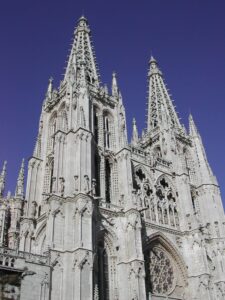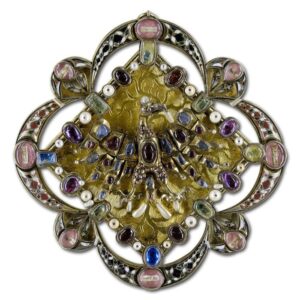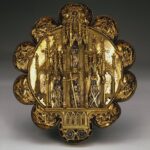
The Gothic period is a late medieval period in art history that spans from roughly 1140 to 1500 AD, with some continuance in the 16th century. It was the successor of the Roman – or Romanesque – style and the Renaissance succeeded it. The term Gothic was given to this art style in the early 16th century by the Italian art historian and architect Giorgio Vasari, who also coined the term renaissance, and it was meant as a derogatory term. In the days this “Gothic” style was termed opus francigenum (from Latin: “French work”).
Then arose new architects who after the manner of their barbarous nations erected buildings in that style which we call Gothic.1
The Gothic style was influenced, most probably, by Arabic ornaments as ogees and the mathematical influences on architecture that came to Europe during the crusades. As a successor of the Romanesque style of the early middle ages, many roman influences are apparent, these can be seen especially in the rounded arches, buttresses, and the floorplan of cathedrals of early Gothic buildings.
The first appearance of Gothic architecture was in 1136 when the Saint-Denis cathedral (the burial site of French Kings, just north of Paris) was being rebuilt. The west facade of the cathedral was rebuilt first and the Romanesque influences are clearly visible in the rounded arches around the doors and windows. The idea of building to the sky – to come closer to God – is the most distinguishing feature of this early Gothic period. Other parts were rebuilt later and as the style evolved, other characteristic elements of the Gothic era emerged in the St.-Denis Basilica. This abbey church is also regarded as the first cathedral to make use of stylistics in the rayonnant – or high Gothic – style.
Building to the sky was one of the most important considerations in the period and this was made possible by the use of arches and buttresses. The arches around the windows and other openings redirected the forces on the buildings downwards to the ground instead of outwards, a concept well-known for centuries before the Gothic period. There were of course limitations to this and buttresses were needed to support the main building to prevent it from collapsing due to these outward forces. While in the Romanesque period, these buttresses were in the form of sidewalls, during the Gothic period they were primarily in the form of flying buttresses. Flying buttresses also became highly decorative instead of functional only. One can see these buttresses decorated with pinnacles, grotesques, and gargoyles.
As with all styles that have a long time span, there was an evolution in the Gothic period and one can divide the Gothic style into 3 main periods.
- Early Gothic (also named romano-gothic) – ca. 1140 to 1200
- High Gothic (also named Rayonnant) – 1200 to 1300
- Late Gothic (also named flamboyant) – 1300 to 1500
Building cathedrals in the Gothic style took many years – sometimes 100 years or more – and as many architects worked in succession on these buildings most of these structures show a combination of the above-mentioned periodic styles.
Cathedrals – the main early Gothic structures – were built on pilgrim routes throughout Europe and urbanization started in the late Middle Ages around these churches. Through these pilgrimage routes, the new Gothic style spread and was soon adopted in other countries with each altering the style to their specific needs and taste. These local adaptations usually are shown in the details and the materials used.
Early Gothic Period
This period evolved from the Romanesque style and is characterized by rounded and pointed arches on a vertical plane. Flying buttresses were used, but are mainly undecorated. Roman buttresses were also used.
High Gothic Period
This period is also known as the Rayonnant period. Not only was the vertical feature considered important, but also allowed light into the churches through stained glass windows. The main window, at the west facade, was a radiant one. Flying buttresses became highly decorated with grotesques, gargoyles, and pinnacles. Quatrefoils were used extensively. The arches became mainly pointed (equilateral arches) after Arabic ogees.
Late Gothic Period
The late Gothic period is also termed the flamboyant period as the quatrefoils were replaced by vesica piscis or fish bladder motifs that resemble almond shapes. These created a sense of movement in the open-worked masonry and stained glass decorations.

Gothic Jewelry
After the fourth crusade got no further than the plundering of Constantinople in 1204 AD, the Byzantine Empire’s powers dwindled. With the demise of the empire its influence on the rest of Europe diminished and eventually, the Byzantine fashion fell from favour. Certain types of jewelry such as earrings and bracelets disappeared from the bodies of European ladies. A new style emerged following the developments in architecture that had started in the 1140s.
A gradual change from Romanesque styles to Gothic ones took place and this was reflected in jewelry designs in the late 13th century. Pointed rather than rounded forms were used and the heavy, dense surface decoration that had been a remnant from the classical past was substituted by more simple and elegant designs. Enamel work became even more beautiful and was used more elaborately. A love of romance with the resulting exchange of gifts of jewelry, an increased supply of gemstones from the East, the rise of gem cutting and the solid establishment of the independent goldsmith/designer caused a new flow of jewelry to adorn the bodies of men and women.
The Gothic style was revived in the 19th century and jewels, as well as buildings, in this style are neo-Gothic.
Gothic Ornaments in Jewelry
One can recognize Gothic and neo-Gothic artifacts by their vertical buildup with a typical ornamental language as:
- Quatrefoils
- Trefoils (trefoils)
- Vesica Piscis (fish bladder)
- Pinnacles
Related Reading
Notes
- ”Vasari, Gorgio. Vite de’ più eccell. pitori, scultori et archi. ca. 1550.↵
